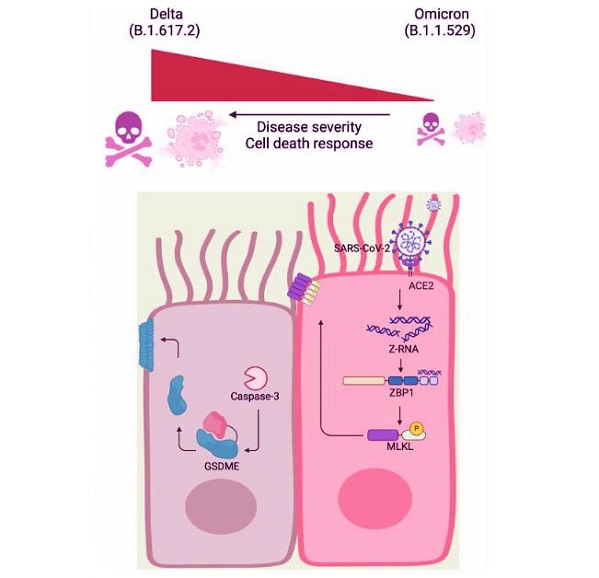Nikhil Prasad Fact checked by:Thailand Medical News Team Jul 16, 2024 9 months, 1 week, 3 days, 8 hours, 45 minutes ago
COVID-19 News: Researchers have uncovered the ways in which COVID-19 causes cell death in human airways, providing crucial insights into the disease's severity and progression. This
COVID-19 News report dives into a groundbreaking study conducted by a team of scientists from various prestigious institutions, shedding light on how SARS-CoV-2, the virus responsible for COVID-19, triggers different types of cell death in the human airway epithelium.
 Proposed mechanism of the cell death responses triggered by SARS-CoV-2.
SARS-CoV-2 infects lung epithelial cells through the ACE2 receptor and generates Z-RNA in the infected cells (labeled in red). The virus-derived Z-RNA is sensed by host protein ZBP1, which initiates necroptosis and phosphorylation and translocation of MLKL. In the bystander cells that are not infected by SARS-CoV-2 (labeled in brown), caspase-3 is activated and cleaves GSDME, and the latter forms GSDME pores in the plasma membrane. Delta (B.1.617.2) and Omicron (B.1.1.529) variants cause necroptosis but in different magnitudes, with Delta being the strongest trigger and Omicron being the weakest trigger of cell death responses.
Key Findings:
-Types of Cell Death
Proposed mechanism of the cell death responses triggered by SARS-CoV-2.
SARS-CoV-2 infects lung epithelial cells through the ACE2 receptor and generates Z-RNA in the infected cells (labeled in red). The virus-derived Z-RNA is sensed by host protein ZBP1, which initiates necroptosis and phosphorylation and translocation of MLKL. In the bystander cells that are not infected by SARS-CoV-2 (labeled in brown), caspase-3 is activated and cleaves GSDME, and the latter forms GSDME pores in the plasma membrane. Delta (B.1.617.2) and Omicron (B.1.1.529) variants cause necroptosis but in different magnitudes, with Delta being the strongest trigger and Omicron being the weakest trigger of cell death responses.
Key Findings:
-Types of Cell Death: The study reveals that SARS-CoV-2 induces three primary types of cell death: necroptosis, apoptosis, and pyroptosis.
-Primary Mechanism: Necroptosis is identified as the primary cell death mechanism in infected cells, while uninfected bystanders undergo apoptosis, and pyroptosis occurs later during infection.
-ZBP1 Role: The study highlights the role of the Z-DNA-binding protein 1 (ZBP1) in mediating necroptosis, driven by the viral Z-RNA binding in infected cells.
The Study
Researchers from the University of North Carolina at Chapel Hill, Washington University School of Medicine, Duke Human Vaccine Institute, Michigan State University, National Institutes of Health, and Duke University School of Medicine in the United States collaborated to explore how SARS-CoV-2 affects human airway epithelial cells (HAECs). These cells express the angiotensin-converting enzyme 2 (ACE2), which the virus uses to enter the cells.
Necroptosis in Infected Cells
The study found that necroptosis is the dominant form of cell death in SARS-CoV-2-infected HAECs. This form of cell death involves a protein called mixed lineage kinase domain-like pseudokinase (MLKL), which forms pores in the cell membrane, leading to cell lysis. The research demonstrated that the activation of MLKL and other necroptotic proteins occurs early during infection, marking necroptosis as the primary response to the virus.
Apoptosis in Bystander Cells
Interestingly, the study discovered that uninfected bystander cells primarily undergo apoptosis, a form of prog
rammed cell death. Apoptosis is mediated by caspases, enzymes that dismantle the cell in a controlled manner. The presence of cleaved caspase-3, an apoptotic marker, was observed in both infected and uninfected cells, indicating a secondary apoptotic response in bystander cells.
Pyroptosis: A Delayed Response
Pyroptosis, another form of inflammatory cell death, was also noted but occurred later in the infection process. Pyroptosis involves the cleavage of gasdermin proteins, which form pores in the cell membrane, leading to cell death and the release of inflammatory cytokines. The study confirmed the presence of gasdermin D (GSDMD) cleavage, although this response was less prominent compared to necroptosis and apoptosis.
Mechanism of Necroptosis
The researchers delved deeper into the mechanism of necroptosis, identifying the role of ZBP1, which recognizes Z-RNA generated during viral replication. ZBP1 interacts with receptor-interacting protein kinase 3 (RIPK3), leading to the phosphorylation of MLKL and the execution of necroptosis. This pathway was significantly more active in cells infected with the Delta variant of SARS-CoV-2 compared to the Omicron variant, correlating with the severity of the disease caused by these variants.
Implications of the Findings
The findings of this study are crucial for understanding the pathogenesis of COVID-19. By pinpointing necroptosis as the primary cell death mechanism in infected cells, researchers can target this pathway for therapeutic interventions. Blocking the interaction between ZBP1 and Z-RNA or inhibiting MLKL activation could potentially mitigate the severe cellular damage caused by SARS-CoV-2.
Further Research and Clinical Applications
The study opens avenues for further research into the specific molecules involved in these cell death pathways and their potential as drug targets. Developing inhibitors that can selectively block necroptosis without affecting other cellular processes could provide a novel treatment strategy for severe COVID-19 cases.
Conclusion
This comprehensive study provides valuable insights into the cellular mechanisms of COVID-19, highlighting the predominant role of necroptosis in infected airway cells. The collaboration of researchers from multiple institutions underscores the importance of interdisciplinary efforts in combating the pandemic.
The study findings were published in the peer-reviewed journal: Science
Immunology.
https://www.science.org/doi/10.1126/sciimmunol.adn0178
For the latest
COVID-19 News, keep on logging to Thailand Medical News.
Read Also:
https://www.thailandmedical.news/news/the-role-of-coronavirus-proteins-in-apoptosis-or-cell-death
https://www.thailandmedical.news/news/sars-cov-2-e-protein-triggers-neuron-cell-death-via-calcium-release
